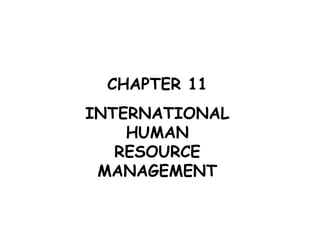HRIS
- 1. CHAPTER 11 INTERNATIONAL HUMAN RESOURCE MANAGEMENT
- 2. COMPONENTS OF HRM Recruitment Selection Training & Development Performance Appraisal Compensation Labor Relations
- 3. INTERNATIONAL HRM (IHRM) Basic HRM issues remain Must choose a mixture of international employees How much to adapt to local conditions?
- 4. EMPLOYEES IN MULTINATIONAL ORGANIZATIONS Host country nationals Expatriates Home country nationals Third country nationals Inpatriates
- 5. MULTINATIONAL MANAGERS Host country or expatriate?
- 6. USING HOST COUNTRY MANAGERS Do they have the expertise for the position? Can we recruit them from outside the company?
- 7. USING EXPATRIATE MANAGERS Do parent country managers have the appropriate skills? Are they willing to take expatriate assignments? Do any laws affect the assignment of expatriate managers?
- 8. IS THE EXPATRIATE WORTH IT? High cost High failure rate
- 9. EXHIBIT 11.1 PAYING FOR THE EXPATRIATE MANAGER
- 10. REASONS FOR U.S. EXPATRIATE FAILURE Spouse fails to adapt Manager fails to adapt Other problems within the family Personality of the manager Level of responsibilities
- 11. Lack of technical proficiency No motivation for assignment Reasons for expatriate failure, continued
- 12. MOTIVATIONS TO USE EXPATS Managers acquire international skills Coordinate and control operations dispersed activities Communication of local needs/strategic information to headquarters
- 13. KEY EXPATRIATE SUCCESS FACTORS Professional/technical competence Relational abilities Motivation Family situation Language skills Willingness to accept position
- 14. PRIORITY OF SUCCESS FACTORS Depends on : assignment length cultural distance amount of required interaction with local people job complexity/responsibility
- 15. EXHIBIT 11.3 SHOWS A DECISION MATRIX USED TO SET PRIORITIES OR DIFFERENT SUCCESS FACTORS DURING SELECTION
- 16. ╠²
- 18. TRAINING RIGOR The extent of effort by trainees and trainers required to prepare the trainees for expatriate positions
- 19. LOW RIGOR TRAINING Short time period Lectures Videos on local culture Briefings on company operations company operations
- 20. HIGH RIGOR TRAINING Lasts over a month Experiential learning Extensive language training Often includes interactions with host country nationals
- 21. EXHIBIT 11.4 SHOWS VARIOUS TRAINING TECHNIQUES AND THEIR OBJECTIVES AS THE RIGOR OF THE CROSS- CULTURAL TRAINING GROWS
- 22. ╠²
- 23. ╠²
- 24. ╠²
- 25. CHALLENGES OF EXPATRIATE PERFORMANCE APPRAISAL Unreliable data Complex and volatile environments Time differences and distance separation Local cultural situations
- 26. STEPS TO IMPROVE THE PROCESS 1. Fit the evaluation criteria to strategy. 2. Fine tune the evaluation criteria 3. Use multiple evaluators with varying periods of evaluation
- 27. EXHIBIT 11.6 Shows several sources of information a superior or the HRM professionals may use to evaluate an expatriate managers
- 28. ╠²
- 30. THE BALANCE SHEET APPROACH Provides a compensation package that equates purchasing power
- 31. BALANCE SHEET COSTS Allowances for cost of living, housing, utilities, furnishing, educational expenses, medical expenses, club memberships, and car and/or driver expenses
- 32. ╠²
- 33. OTHER APPROACHES Parent country wages everywhere Wean expatriates from allowances Pay based on local or regional markets Cafeteria selection of allowances Global pay systems
- 34. THE REPATRIATION PROBLEM Difficult for many organizations "Reverse culture shock" Expatriates must relearn own national and organizational culture Includes whole family
- 35. STRATEGIES FOR SUCCESSFUL REPATRIATION PROVIDE: A strategic purpose for repatriation A team to aid the expatriate Home country information sources Training and preparation for the return Support for expatriate and family
- 36. WOMEN EXPATRIATES: TWO IMPORTANT "MYTHS" Myth 1: women do not wish to take international assignments Myth 2: women will fail in international assignments because of the foreign culture's prejudices against local women
- 37. SUCCESSFUL WOMEN EXPATRIATES Foreign not female emphasize nationality not gender The woman's advantage strong in relational skills wider range of interaction options
- 38. MULTINATIONAL STRATEGY AND IHRM
- 39. IHRM ORIENTATIONS Ethnocentric Polycentric Regiocentric Global
- 40. IHRM ORIENTATION AND MULTINATIONAL STRATEGY Early stages of internationalization = ethnocentric IHRM Multilocal strategies = ethnocentric or regiocentric Regional strategy = closer to the global
- 41. International strategy = ethnocentric or polycentric IHRM Transnational strategies = a global IHRM
- 42. CONCLUSIONS HRM functions IHRM challenges Expatriate managers The role of women in multinational organizations Multinational strategies and IHRM orientations










































